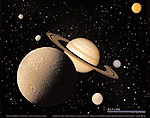Saturn, the sixth planet from the sun and the second largest in the solar system, is known for its stunning rings that make it one of the most recognizable planets. It is named after the Roman god of agriculture and wealth, and is often referred to as the “Jewel of the Solar System.”
With its beautiful rings and numerous moons, Saturn has captured the imagination of scientists and space enthusiasts for centuries. Let’s delve into some fascinating facts about this gas giant.
Saturn Fact Sheet
Saturn is primarily composed of hydrogen and helium, similar to Jupiter. It has a diameter of about 74,900 miles, making it around nine times larger than Earth. The planet’s iconic rings are made up of ice and rock particles ranging in size from tiny grains to massive chunks.
Saturn has a unique feature known as a hexagon-shaped storm at its north pole. This mysterious six-sided jet stream has puzzled scientists since its discovery by the Voyager spacecraft in the 1980s. The planet also has a large, rocky core surrounded by layers of metallic hydrogen and helium.
One of Saturn’s most intriguing moons is Titan, which is larger than the planet Mercury. Titan has a thick atmosphere that contains methane and ethane, and its surface features lakes of liquid methane. Another interesting moon is Enceladus, which has geysers that spew water vapor and icy particles into space.
Despite its immense size, Saturn has a relatively low density, which means it would float in water if a body of water large enough were available. The planet’s rings are constantly changing and may disappear altogether in the distant future as they are gradually pulled into Saturn by gravity.
Exploration of Saturn has been conducted by spacecraft such as Voyager 1 and 2, Cassini, and the upcoming Dragonfly mission. These missions have provided valuable insights into the planet’s atmosphere, rings, and moons, paving the way for further exploration of this intriguing world.
In conclusion, Saturn is a mesmerizing planet with its stunning rings, diverse moons, and unique features. Its beauty and mysteries continue to captivate scientists and space enthusiasts alike, inspiring us to learn more about the wonders of our solar system.
